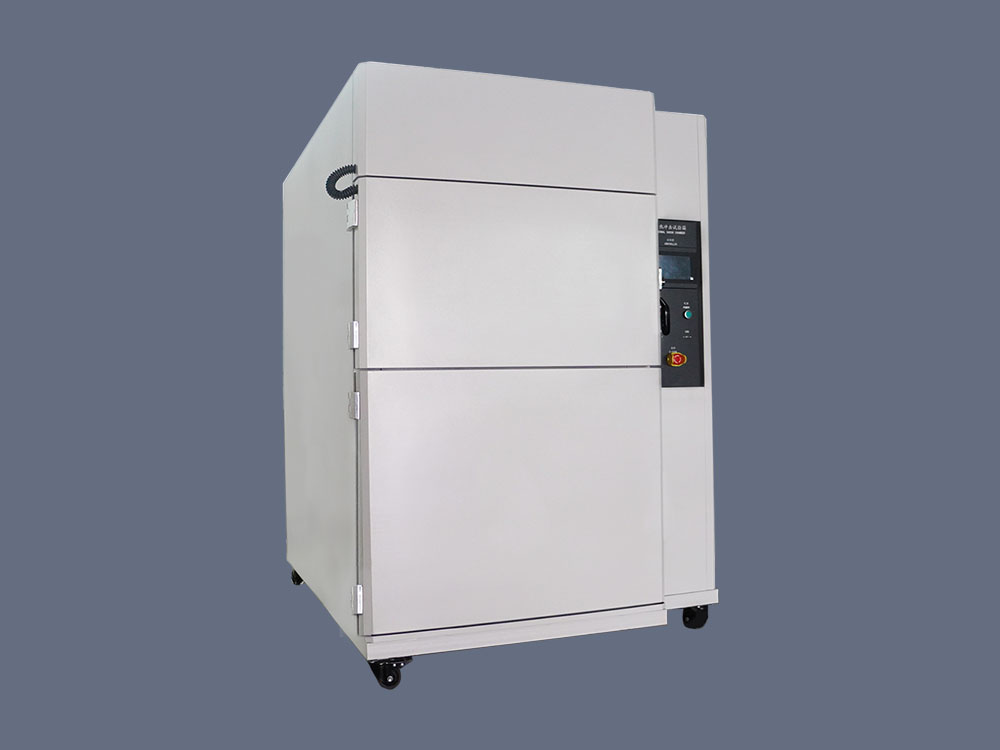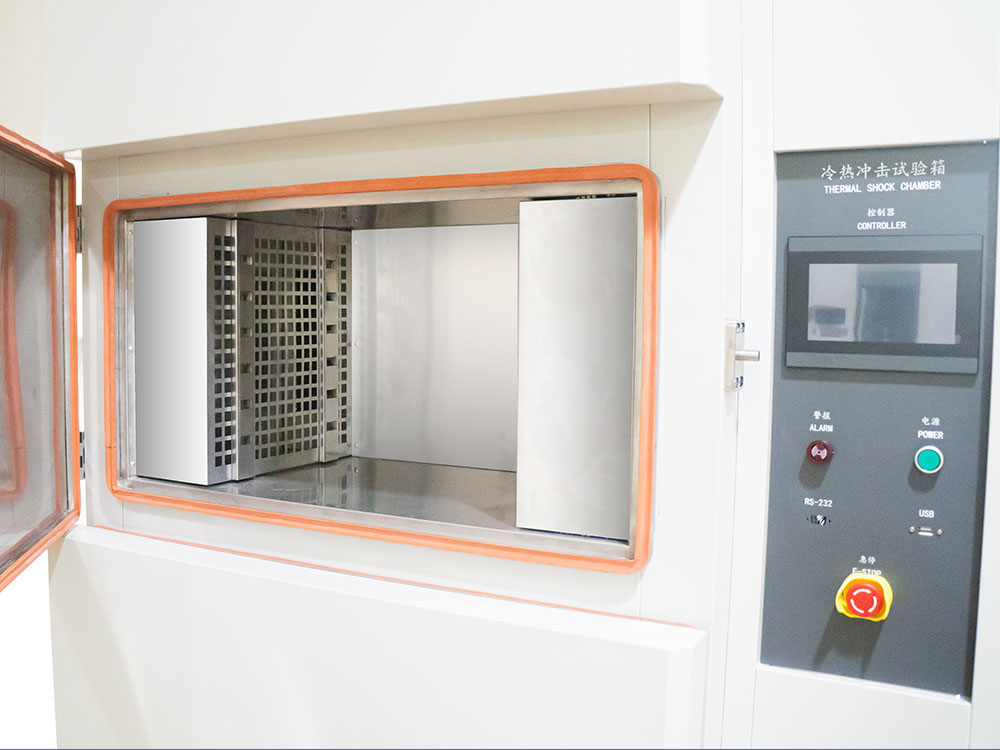Cold and thermal shock test chamber why open time long power jump?
Cold and thermal shock test chambers have long open times. This is due to power jumps, equipment issues, and environmental factors.
Power supply problems:
A loose or damaged power cord may cause power jumps. Long-term movement, vibration, or daily pulling may loosen the power cord. It could even break the internal wires. This may disconnect the equipment from the power supply and cause a power failure.
Problems of the equipment itself:
Aging internal parts, poor heat dissipation, and other issues may cause power jumps. For example, short-circuiting or leakage of the heating tube will trip the test box. Also, if the equipment’s power use exceeds the circuit breaker’s max current, it will trip.
Environmental factors:
High ambient temperature, poor heat dissipation, etc. may also lead to equipment tripping. After long use, poor heat dissipation will raise the equipment’s temperature. It will then trip.
Solution and preventive measures:
Regularly check the power cord and plug to ensure that the connection is firm and not loose or damaged.
Regularly maintain the equipment. Check the heat dissipation system and the aging components. Replace any aging parts in time.
Match the equipment load to the circuit breaker. This will avoid tripping from an overload.
Ventilate the area around the equipment to prevent tripping from heat.
These measures can cut the thermal shock test chamber‘s open time after long power losses. They will protect the equipment and product quality.
Thermal shock test chamber test in what case need to add water?
Temperature shock test chamber test process, in the following cases need to add water:
1. Temperature and humidity conditions:
We want to test. Temperature and humidity can affect a test chamber’s water use. It tests for temperature shock. We know that the natural environment has humidity. If the temperature and humidity are too low, we must add water to the tank of the temperature shock test box.
2.The number of switching doors:
If you often open and close the door, it will lose humidity. This will increase the humidity and water use over time. So, check the water source occasionally. If the water source is too small, we need to add water to the water tank of the temperature shock test box.
3. Whether there is humidity test:
Usually, test the temperature and humidity conditions. For tests of only high and low temperatures, do not use the humidity. It will not consume any water. So, we usually do not need to add water to the temperature shock test box. If there is a humidity test, then you need to add water to the water tank of the temperature shock test box.
4. Equipment volume:
Water use also depends on the size of its temperature shock test chamber. The larger the equipment, the greater the water consumption.
In summary, we need to add water to the test chamber after the temperature shock test. There are four cases to check for. If the temperature shock test chamber needs water, open the tank’s injection port. Then, add pure water. It is safe to add water during the test. You need not worry about affecting the test or damaging the equipment.
Cold and thermal shock test chamber why heating?
The main reasons why we need to heat the thermal shock test chamber include the following:
Simulation of extreme environments:
The hot and cold shock test chamber can reach a high temperature. Its heating function causes this. This simulates extreme high temperature environments to meet the required standards. This high temperature environment is critical for testing the heat resistance of materials.
Balancing temperature changes:
The heating function helps to stabilize temperature changes and transitions. It reduces temperature gradients. It slows temperature drops. This improves energy efficiency and ensures accurate tests.
Compensating for heat loss:
During thermal shock, the heating system prevents rapid cooling. It compensates for heat loss. This ensures a stable, reliable test environment.
Protecting the test sample:
In the high temperature state, the heating system raises the test chamber’s temperature. It does this by controlling the heating element’s on-time and current. This protects the test sample from sudden temperature changes.
Realisation of thermal and cold shock tests:
The thermal and cold shock tester works on refrigeration and heating technology. The refrigeration system cools the test chamber for pre-cooling. It must reach a low, required temperature. When you need to warm up, the heating system starts. This gradually raises the chamber’s temperature, completing the cold thermal shock test.
In summary, the heating function of the thermal shock test chamber is vital. It simulates an extreme environment. It balances the temperature, stops heat loss, and protects the samples.
How to use the thermal shock tester?
Use method
1.Preparation, place the thermal shock test chamber on a stable ground with good ventilation and no obstruction, and connect the power supply. Check whether the inside of the test box is clean, to ensure that no foreign matter affects the test results.
2. Set the parameters, according to the experimental requirements, set the temperature range of the thermal shock test chamber, the rate of change and duration and other parameters. Usually, the test box will have a control panel, you can operate the panel buttons or touch screen settings.
3. Prepare the samples, according to the experimental requirements, prepare the samples or products to be tested, and in accordance with standard methods placed in the test tank inside the test chamber. Pay attention to the spacing and layout between samples to ensure the accuracy of the test.
4. Start the test, set the parameters and place the sample, start the thermal shock test chamber for testing. The test chamber will automatically carry out temperature changes according to the set parameters to carry out the thermal shock test.
5. Monitor the experimental process, in the testing process, regularly check the temperature changes inside the test chamber, pay attention to observe the sample state changes. You can use the built-in temperature sensor and monitoring system to monitor the temperature changes and sample response in real time.
6. End the test, after the end of the experiment, close the test chamber and remove the sample. According to the requirements of the experiment, carry out the corresponding data recording and analysis to assess the performance changes of the sample under the conditions of thermal shock.
Precautions
1. Safe operation, pay attention to safety when using the thermal shock test chamber, avoid touching hot surfaces and high temperature parts, so as not to cause burns or other accidental injuries.
2. Avoid overloading, when placing samples, avoid excessive placement, so as not to affect the ventilation and heat dissipation effect of the test box, resulting in uneven temperature or test box failure.
3. Regular maintenance, regular cleaning and maintenance of the thermal shock test chamber, including cleaning the interior and exterior of the test chamber, check the power cord and electrical components are normal, etc., to ensure that the test chamber’s safe and stable operation.
4. Pay attention to temperature control, in the experiment, pay attention to the control of the temperature of the thermal shock test chamber, to avoid the temperature is too high or too low, so as not to affect the accuracy of the experimental results.
5. Avoid opening the door frequently, in the experimental process to reduce the frequency of opening the door, so as not to destroy the temperature stability inside the test chamber, affecting the experimental results.
6. Prohibit the use of flammable items, prohibit the placement of flammable and explosive substances in the thermal shock test chamber to avoid fire or explosion.
For more environmental test chamber, Please visit: https://chiuventionclimatechamber.com
For more environmental test simulation programmes,environmental testing knowledge, instrument knowledge, and environmental testing laboratory knowledge, please contact us: [email protected]

